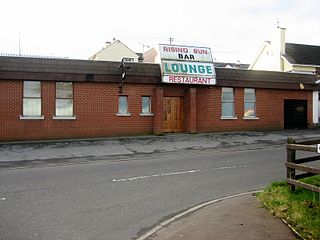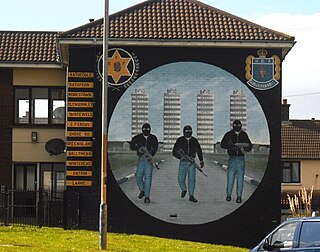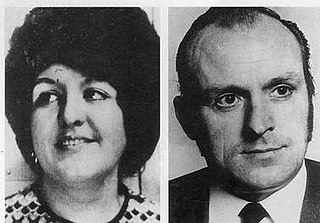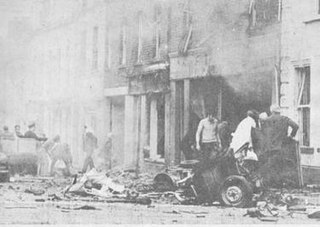Related Research Articles

The Ulster Defence Association (UDA) is an Ulster loyalist paramilitary group in Northern Ireland. It was formed in September 1971 as an umbrella group for various loyalist groups and undertook an armed campaign of almost 24 years as one of the participants of the Troubles. Its declared goal was to defend Ulster Protestant loyalist areas and to combat Irish republicanism, particularly the Provisional Irish Republican Army (IRA). In the 1970s, uniformed UDA members openly patrolled these areas armed with batons and held large marches and rallies. Within the UDA was a group tasked with launching paramilitary attacks that used the cover name Ulster Freedom Fighters (UFF) so that the UDA would not be outlawed. The British government proscribed the UFF as a terrorist group in November 1973, but the UDA itself was not proscribed until August 1992.
The Red Hand Defenders (RHD) is an Ulster loyalist paramilitary group in Northern Ireland. It was formed in 1998 by loyalists who opposed the Belfast Agreement and the loyalist ceasefires. Its members were drawn mostly from the Ulster Defence Association (UDA) and Loyalist Volunteer Force (LVF). The name had first been used by Red Hand Commandos dissident Frankie Curry in 1996 and he was the leading figure in what was a somewhat unstructured organization until he was killed in 1999. It is named after the Red Hand of Ulster.

Castlerock is a seaside village in County Londonderry, Northern Ireland. It is five miles west of Coleraine, and part of Causeway Coast and Glens district. It is very popular with summer tourists, with numerous apartment blocks and two caravan sites. Castlerock Golf Club has both 9-hole and 18-hole links courses bounded by the beach, the River Bann and the Belfast to Derry railway line. The village had a population of 1,155 people at the 2021 census, and is where near by village Articlave F.C play their home games.
John White is a former leading loyalist in Northern Ireland. He was sometimes known by the nickname 'Coco'. White was a leading figure in the loyalist paramilitary group, the Ulster Defence Association (UDA) and, following a prison sentence for murder, entered politics as a central figure in the Ulster Democratic Party (UDP). Always a close ally of Johnny Adair, White was run out of Northern Ireland when Adair fell from grace and is no longer involved in loyalist activism.

Kilrea is a village, townland and civil parish in County Londonderry, Northern Ireland. It gets its name from the ancient church that was located near to where the current Church of Ireland is located on Church Street looking over the town. It is near the River Bann, which marks the boundary between County Londonderry and County Antrim. In the 2011 Census it had a population of 1,678 people. It is situated within Causeway Coast and Glens district.

Ulster Resistance (UR), or the Ulster Resistance Movement (URM), is an Ulster loyalist paramilitary movement established by the Democratic Unionist Party (DUP) in Northern Ireland in November 1986 in opposition to the Anglo-Irish Agreement.

The Greysteel massacre was a mass shooting that took place on the evening of 30 October 1993 in Greysteel, County Londonderry, Northern Ireland. Members of the Ulster Defence Association (UDA), a loyalist paramilitary group, opened fire on civilians in a crowded pub during a Halloween party, killing eight and wounding nineteen. The pub was targeted because it was frequented by Catholics, though two of the victims were Protestant. The group claimed responsibility using their cover name "Ulster Freedom Fighters", saying the attack was revenge for the Shankill Road bombing by the Provisional IRA a week earlier. Four men were sentenced to life imprisonment for the massacre but were released in 2000 under the terms of the Good Friday Agreement.

The Loughinisland massacre took place on 18 June 1994 in the small village of Loughinisland, County Down, Northern Ireland. Members of the Ulster Volunteer Force (UVF), a loyalist paramilitary group, burst into a pub with assault rifles and fired on the customers, killing six civilians and wounding five. The pub was targeted because it was frequented mainly by Catholics, and was crowded with people watching the Republic of Ireland play against Italy in the 1994 FIFA World Cup. It is thus sometimes called the "World Cup massacre". The UVF claimed the attack was retaliation for the killing of three UVF members by the Irish National Liberation Army (INLA).
The Castlerock killings took place on 25 March 1993 in the village of Castlerock, County Londonderry, Northern Ireland. Members of the Ulster Defence Association (UDA), a loyalist paramilitary group, shot dead three Catholic civilians and a Provisional Irish Republican Army (IRA) member as they arrived for work in a van. Another was wounded. The "Ulster Freedom Fighters" (UFF) claimed it had targeted an IRA member and his "accomplices". A UDA member was later imprisoned for his part in the attack and in the Greysteel massacre several months later, but was released in 2000 under the terms of the Good Friday Agreement.
John Dallat was an Irish politician in the Social Democratic and Labour Party (SDLP) who represented East Londonderry in the Northern Ireland Assembly from 1998 to 2016, and then from 2017 until his death in 2020.
The Real Ulster Freedom Fighters, otherwise known as the Real UFF, is a dissident loyalist paramilitary group in Northern Ireland. It was founded in early 2007 by former members of the Ulster Defence Association (UDA) /Ulster Freedom Fighters (UFF). They reportedly committed 24 attacks from 2009 to 2011 in County Antrim. They are believed to number fewer than 50 members.

Gerard Casey was a member of the 1st North Antrim Brigade of the Provisional Irish Republican Army.

The UDA South East Antrim Brigade was previously one of the six brigades of the Ulster Defence Association (UDA) and are heavily involved in the drug trade. It is claimed they control "100%" of an illegal drugs network in south-east County Antrim, Northern Ireland. A mural in support of the group lists its areas of activity as being Rathcoole, Rathfern, Monkstown, Glengormley and Whitewell, all of which are part of Newtownabbey, as well as Carrickfergus, the Shore Road, Greenisland, Ballymena, Whitehead, Antrim and Larne. A newer mural in the Cloughfern area of Newtownabbey and flags have updated the areas to include Ballycarry, Ballyclare, the rural hinterland of Ballymena called 'Braidside' and despite not being in County Antrim, the town of Newtownards. The Guardian has identified it as "one of the most dangerous factions". The Irish News described the brigade as 'powerful' and at one time being 'the most bloody and murderous gang operating within the paramilitary organisation'. Since 2007 the South East Antrim Brigade has operated independently of the UDA following a fall-out.
This is a timeline of actions by the Ulster Defence Association (UDA), a loyalist paramilitary group formed in 1971. Most of these actions took place during the conflict known as "the Troubles" in Northern Ireland. The UDA's declared goal was to defend Loyalist areas from attack and to combat Irish republican paramilitaries. However, most of its victims were Irish Catholic civilians, who were often chosen at random.
William McFarland, also known as "the Mexican", is a Northern Irish loyalist paramilitary. He was a leading figure in the Ulster Defence Association (UDA), he had served as head of the North Antrim and Londonderry East Tyrone Brigade of the group.
Ken Barrett is a Northern Irish former loyalist paramilitary. A leading figure within the Ulster Defence Association (UDA), Barrett was involved in collusion between loyalists and the British security forces during the Troubles.

The killings of Paddy Wilson and Irene Andrews took place in Belfast, Northern Ireland on the night of 25/26 June 1973. The victims, Roman Catholic Senator Paddy Wilson and his Protestant friend Irene Andrews, were hacked and repeatedly stabbed to death by members of the "Ulster Freedom Fighters" (UFF). This was a cover name for the Ulster Defence Association (UDA), a then-legal Ulster loyalist paramilitary organisation. John White, the UFF's commander, who used the pseudonym "Captain Black", was convicted of the sectarian double murder in 1978 and sentenced to life imprisonment. White, however maintained that the UFF's second-in-command Davy Payne helped him lead the assassination squad and played a major part in the attack. Although questioned by the Royal Ulster Constabulary (RUC) after the killings, Payne admitted nothing and was never charged.

On 12 June 1973 the Provisional IRA detonated two carbombs in Coleraine, County Londonderry, Northern Ireland. The first bomb exploded at 3:00 pm on Railway Road, killing six people and injuring 33; several lost limbs and were left disabled for life. A second bomb exploded five minutes later at Hanover Place. This did not cause any injuries, although it added to the panic and confusion in the area. The IRA had sent a warning for the second bomb but said it had mistakenly given the wrong location for the first.
Andrew Robinson is a Northern Irish former loyalist paramilitary leader. Robinson held the rank of "Brigadier" in the Ulster Defence Association (UDA) and was leader of the organisation's North Antrim and Londonderry Brigade as well as a member of the UDA's Inner Council.
On 14 November 1992, the Ulster Defence Association (UDA), a loyalist paramilitary group, launched an attack on James Murray's bookmakers on the Oldpark Road in Belfast, Northern Ireland. A gunman fired on the customers with an assault rifle, while another threw a grenade inside. Three civilians were killed and thirteen wounded. The shop was in a Catholic and Irish nationalist area, and all of the victims were local Catholics. The attack was likened to the Sean Graham bookmakers' shooting carried out by the UDA earlier that year.
References
- ↑ Wood, Ian S. Crimes of Loyalty: A History of the UDA. Edinburgh University Press, 2006. p.173
- ↑ Greysteel - Confessions of a serial killer Belfast Telegraph
- ↑ Chronology of the Conflict: October 1993, CAIN
- 1 2 Loyalist killer found guilty of assault, The Irish Times, 22 October 2009, retrieved 27 October 2009
- 1 2 3 4 5 6 7 Was this loyalist murderer in the police's pay?, David McKittrick, The Independent, 18 February 2006, retrieved 27 October 2009
- ↑ NI prisoners savour freedom, BBC News, 28 July 2000
- ↑ Freed Ulster killer 'paid £50,000 salary for being police informer', Rosie Cowan and Owen Bowcott, The Guardian, 16 February 2009
- ↑ "BBC NEWS - UK - Northern Ireland - Police 'could not stop massacre'". BBC.
- ↑ UFF killer Torrens Knight claim is refuted by Kilrea Apprentice Boys-Coleraine Times
- ↑ Greysteel Killer-I am a changed man-The Newsletter
- ↑ Torrens Knight-I have changed, leave me alone-Coleraine Times
- ↑ Loyalist killer returned to jail, Éanna Ó Caollaí, The Irish Times, 27 October 2009
- 1 2 "Torrens Knight jailed for assault". The Irish Times .
- ↑ TUV 'won't take action' over Knight petition, BBC News, 4 December 2009
- ↑ "Greysteel UFF murderer Torrens Knight freed from prison - BelfastTelegraph.co.uk".